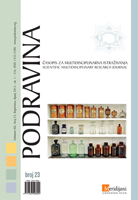- REVITALIZACIJA STARIH INDUSTRIJSKIH OBMOČIJ V JUGOVZHODNI EVROPI
- PRINOS POVIJESTI LJEKARNIŠTVA U SJEVEROZAPADNOJ HRVATSKOJ
- TRADICIJSKI NAČIN GRADNJE RURALNIH OBJEKATA U PODRAVINI
- ROLE OF THERMAL-TOURISM IN REGIONAL DEVELOPMENT – A CASE STUDY FROM HUNGARIAN SIDE OF THE HUNGARIAN-CROATIAN BORDER
- DIE STELLUNG KROATIENS INNERHALB DES KÖNIGREICHS UNGARN IN DER FRüHEN NEUZEIT (THE KINGDOM OF CROATIA WITHIN THE KINGDOM OF HUNGARY IN THE EARLY MODERN ERA)
- KATEGORIJE ZELENOG KADRA 1918. GODINE I OSVRT NA NJIHOVO DJELOVANJE U PODRAVINI I PRIGORJU
- TOMO JALŽABETIĆ DO OSNIVANJA HRVATSKE PUČKE SELJAČKE STRANKE BRAĆE RADIĆ
- RURALNA GRADITELJSKA BAŠTINA U FUNKCIJI TURISTIČKE PONUDE HRVATSKE
- PRILOG POZNAVANJU NAJRANIJE ŽIDOVSKE ZAJEDNICE U BJELOVARU DO IZGRADNJE PRVE SINAGOGE 1881. GODINE
- REGESTA ZA POVIJEST KOPRIVNICE DO 1600. GODINE (IZBOR)
- PRIKAZI NOVIH KNJIGA, ČASOPISA I ZNANSTVENIH SKUPOVA
DIE STELLUNG KROATIENS INNERHALB DES KÖNIGREICHS UNGARN IN DER FRüHEN NEUZEIT (THE KINGDOM OF CROATIA WITHIN THE KINGDOM OF HUNGARY IN THE EARLY MODERN ERA)
The present study investigates the changes which occurred in the relationship of Croatia and Sla- vonia to the kingdom of Hungary during the months following the battle of Mohács. The first part of the study examines the differences within the medieval structure of the two provinces. Croatia as a partner county of the Hungarian kingdom enjoyed considerable independence, and the conception of a voluntary attachment to the Holy Crown was always part of the ideology of the local nobility. Yet the independent Croatian coronation ordo disappeared, and the Croatian royal title remained attached to the Holy Crown, the devotion to which was always strong there. Slavonia, on the other hand, was more closely linked to the kingdom of Hungaiy, for it was territorially part of it, its secular and ecc- lesiastical administration was identical, and devotion to the Hungarian saints was important there. These differences are perfectly reflected by their names of regnum Croacie and regnum Sclavonic (ancient Hungaria Tótország, germán Windischland). The two regions of different institutional framework came to be ever more closely linked thanks to the Ottoman incursions in the second half of the 15th century. The first sign of this process was the union (albeit not definitive) of the banal titles of Slavonia and Croatia in 1476. In the age of the Jage- llonians the Buda court proved increasingly unable to resist the Ottoman menace, which led to trou- bles in the government of the territory beyond the river Drava. After the fall of Belgrade (1521) archduke Ferdinand of Habsburg tried to stabilise with armed forces the Croatian borderland, and established closed links with the Croatian nobility in his service. Consequently, the Croatian estates supported him against János Szapolyai, voivode of Transylvania, in the struggle for the Hungarian throne after the battle of Mohács. Yet it was not the election of Ferdinand as an independent king of Croatia which took place on 1 Januaiy 1527, but merely a confirmation of the decision of the parlia- ment of Pozsony made on 16 December 1526. That it was so is proved by the fact that Ferdinand later governed this territory through the Hungarian institutions of government (chancellery, chamber, Hun- garian council etc.). Slavonia, on the other hand, joined János Szapolyai who had been crowned king of Hungary on 11 November 1526. The Slavonian estates assembled at Dombró in January 1527 accepted him as their ruler, but no royal election took place there; it would have strictly contradicted both the limited authority of the provincial assembly and the legal traditions of the Slavonian nobility. Consequently, the decisions taken by the two assemblies can only be contextualiséd in the framework of the history of Hungary in general.
Izvorni znanstveni rad / Original scientific paperSzabolcs Varga

